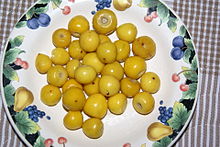Byrsonima crassifolia
| Byrsonima crassifolia | |
|---|---|

| |
| Byrsonima crassifolia | |
| Scientific classification | |
| Kingdom: | |
| Phylum: | |
| (unranked): | |
| Order: | |
| Family: | |
| Genus: | |
| Species: | B. crassifolia
|
| Binomial name | |
| Byrsonima crassifolia | |
| Synonyms | |
 | |||||||||||||||||||||||||||||||||||||||||||||||||
| Nutritional value per 100 g (3.5 oz) | |||||||||||||||||||||||||||||||||||||||||||||||||
|---|---|---|---|---|---|---|---|---|---|---|---|---|---|---|---|---|---|---|---|---|---|---|---|---|---|---|---|---|---|---|---|---|---|---|---|---|---|---|---|---|---|---|---|---|---|---|---|---|---|
| Energy | 306 kJ (73 kcal) | ||||||||||||||||||||||||||||||||||||||||||||||||
16.97 g | |||||||||||||||||||||||||||||||||||||||||||||||||
| Sugars | 8.31 g | ||||||||||||||||||||||||||||||||||||||||||||||||
| Dietary fiber | 7.5 g | ||||||||||||||||||||||||||||||||||||||||||||||||
1.16 g | |||||||||||||||||||||||||||||||||||||||||||||||||
0.66 g | |||||||||||||||||||||||||||||||||||||||||||||||||
| |||||||||||||||||||||||||||||||||||||||||||||||||
| †Percentages estimated using US recommendations for adults,[3] except for potassium, which is estimated based on expert recommendation from the National Academies.[4] | |||||||||||||||||||||||||||||||||||||||||||||||||
Byrsonima crassifolia is a species of flowering plant in the acerola family, Malpighiaceae, that is native to tropical America. It is valued for its small, sweet, yellow fruit, which are strongly scented. Common names include nanche, nance, chacunga, changunga, craboo, kraabu, savanna serrette (or savanna serret) and golden spoon.
Description and habitat
Byrsonima crassifolia is a slow-growing large shrub or tree to 33 ft (10 m). Sometimes cultivated for its edible fruits, the tree is native and abundant in the wild, sometimes in extensive stands, in open pine forests and grassy savannas, from central Mexico, through Central America, to Colombia, Peru, Bolivia and Brazil; it also occurs in Trinidad, Barbados, Curaçao, St. Martin, Dominica, Guadeloupe, Puerto Rico, Haiti, the Dominican Republic and throughout Cuba and the Isle of Pines. The nance is limited to tropical and subtropical climates. In Central and South America, the tree ranges from sea-level to an altitude of 6,000 ft (1,800 m). It is highly drought-tolerant.
Example ecoregions of occurrence
Found in a number of tropical and subtropical ecoregions of the Americas that feature conifers, an example ecoregion of occurrence for B. crassifolia is the Belizean pine forests.[5]
Uses

The fruits are eaten raw or cooked as dessert. In rural Panama, the dessert prepared with the addition of sugar and flour, known as pesada de nance, is quite popular. The fruits are also made into dulce de nance, a candy prepared with the fruit cooked in sugar and water. In Nicaragua (where the fruit is called nancite), it is a popular ingredient for several desserts, including raspados (mixed with ice).
The fruits are often used to prepare carbonated beverages, flavor mezcal-based liqueurs, or make an oily, acidic, fermented beverage known as chicha, the standard term applied to assorted beer-like drinks made of fruits or maize. Nance is used to distill a rum-like liquor called crema de nance in Costa Rica. Mexico produces a licor de nanche.
See also
References
- ^ "Byrsonima crassifolia (L.) Kunth". TROPICOS. Missouri Botanical Garden. Retrieved 2010-03-30.
- ^ "Byrsonima crassifolia (L.) Kunth". Germplasm Resources Information Network. United States Department of Agriculture. 2002-09-13. Retrieved 2010-03-30.
- ^ United States Food and Drug Administration (2024). "Daily Value on the Nutrition and Supplement Facts Labels". FDA. Archived from the original on 2024-03-27. Retrieved 2024-03-28.
- ^ National Academies of Sciences, Engineering, and Medicine; Health and Medicine Division; Food and Nutrition Board; Committee to Review the Dietary Reference Intakes for Sodium and Potassium (2019). "Chapter 4: Potassium: Dietary Reference Intakes for Adequacy". In Oria, Maria; Harrison, Meghan; Stallings, Virginia A. (eds.). Dietary Reference Intakes for Sodium and Potassium. The National Academies Collection: Reports funded by National Institutes of Health. Washington, DC: National Academies Press (US). pp. 120–121. doi:10.17226/25353. ISBN 978-0-309-48834-1. PMID 30844154. Retrieved 2024-12-05.
- ^ C. Michael Hogan & World Wildlife Fund. 2012. Belizean pine forests. ed. M. McGinley. Encyclopedia of Earth. Washington DC
External links
![]() Data related to Byrsonima crassifolia at Wikispecies
Data related to Byrsonima crassifolia at Wikispecies
- Byrsonima
- Tropical fruit
- Trees of Central America
- Trees of Barbados
- Trees of Cuba
- Trees of Puerto Rico
- Trees of northern South America
- Trees of Brazil
- Trees of Bolivia
- Trees of Peru
- Trees of Paraguay
- Trees of Mexico
- Trees of the Dominican Republic
- Trees of Haiti
- Trees of Curaçao
- Trees of Dominica
- Trees of Guadeloupe
- Trees of Îles des Saintes
- Trees of Saint Martin and Saint Barthélemy
- Trees of Trinidad and Tobago
- Flora of Central Mexico
- Flora of Southern Mexico
- Plants described in 1822
